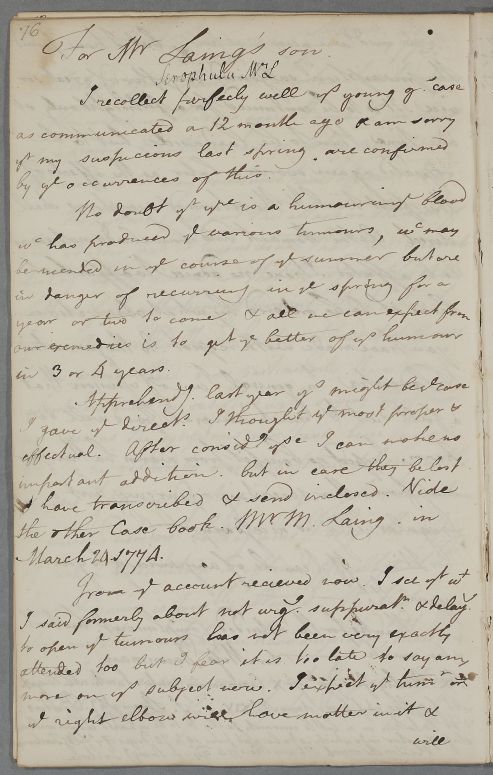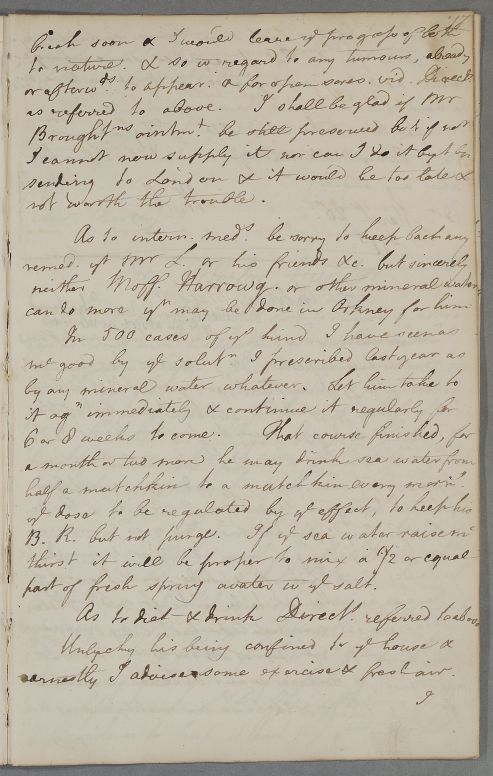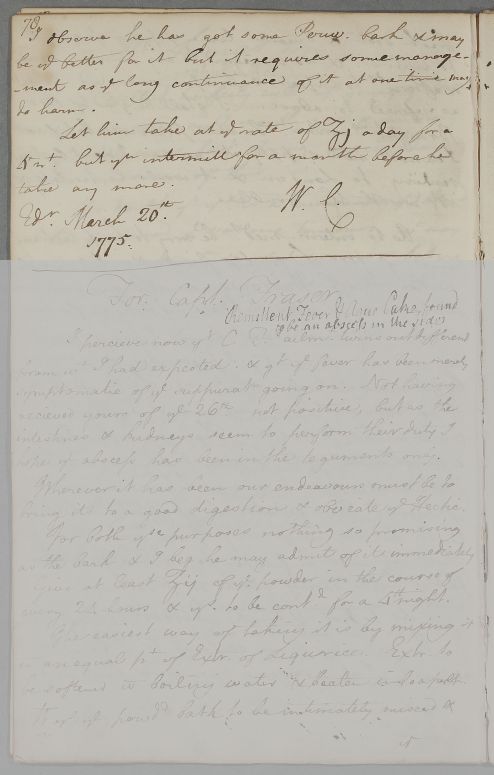
The Consultation Letters of Dr William Cullen (1710-1790) at the Royal College of Physicians of Edinburgh
[ID:3775] From: Dr William Cullen (Professor Cullen) / To: [ADDRESSEE UNKNOWN] / Regarding: Mr Malcolm Laing (Patient) / 20 March 1775 / (Outgoing)
Reply 'For Mr Laing's son', who is being treated for a tumour on his leg.
- Facsimile
- Normalized Text
- Diplomatic Text
- Metadata
- Case
- People
- Places
Facsimile
There are 3 images for this document.

[Page 1]

[Page 2]

[Page 3]
Metadata
| Field | Data |
|---|---|
| DOC ID | 3775 |
| RCPE Catalogue Number | CUL/1/1/5/38 |
| Main Language | English |
| Document Direction | Outgoing |
| Date | 20 March 1775 |
| Annotation | None |
| Type | Scribal copy ( includes Casebook Entry) |
| Enclosure(s) | No enclosure(s) |
| Autopsy | No |
| Recipe | No |
| Regimen | No |
| Letter of Introduction | No |
| Case Note | No |
| Summary | Reply 'For Mr Laing's son', who is being treated for a tumour on his leg. |
| Manuscript Incomplete? | No |
| Evidence of Commercial Posting | No |
Case
Cases that this document belongs to:
| Case ID | Description | Num Docs |
|---|---|---|
| [Case ID:18] |
Case of Malcolm Laing of Strinzia (in Orkney), who has a scrophulous complaint. |
5 |
People linked to this document
| Person ID | Role in document | Person |
|---|---|---|
| [PERS ID:1] | Author | Dr William Cullen (Professor Cullen) |
| [PERS ID:1756] | Patient | Mr Malcolm Laing |
| [PERS ID:1] | Patient's Physician / Surgeon / Apothecary | Dr William Cullen (Professor Cullen) |
| [PERS ID:359] | Other Physician / Surgeon | Mr Charles Broughton |
| [PERS ID:2082] | Patient's Relative / Spouse / Friend | Mr Robert Laing (of Strynzia, Orkney) |
Places linked to this document
| Role in document | Specific Place | Settlements / Areas | Region | Country | Global Region | Confidence |
|---|---|---|---|---|---|---|
| Place of Writing | Cullen's House / Mint Close | Edinburgh | Edinburgh and East | Scotland | Europe | certain |
| Mentioned / Other | Orkneys | Scotland | Europe | certain | ||
| Mentioned / Other | London | London and South-East | England | Europe | certain |
Normalized Text
For Mr Laing's son
I recollect perfectly well the young Gentleman's case
as communicated a 12 month ago & am sorry
that my suspicions last spring are confirmed
the occurrences of this.
No doubt that there is a humour in the blood
which has produced the various tumours,
which may
be mended in the course of the summer but are
in danger of recurring in the spring for a
year or two to come & all we can expect from
our remedies is to get the better of this humour
in 3 or 4 years.
Apprehending last year this might be [the case?]
I gave the directions I thought the most proper &
effectual. After considering these I can make no
important addition. but in case they be lost
I have transcribed & send inclosed. Vide
the other Case book. Mr M. Laing in
March 24. 1774. 1
From the account recieved now. I see that what
I said formerly about not [encgencouraging?] suppuration & delaying
to open the tumours has not been very exactly
attended too but I fear it is too late to say any
more on this subject now. 2 I expect the tumour on the elbow will have matter in it &
will
[Page 2]
break soon & I would leaue the progress of both
to nature. & so with regard to any tumours, already
or afterwards to appear & for open sores vid. Direct
as referred to above. I shall be glad if Mr
Broughton's ointment 3 i be still preserved but if not
I cannot now supply it nor can I do it [but by?]
sending to London & it would be too late &
not worth the trouble.
As to internal medicines be sorry to keep back any
remedy that Mr L. or his friends &c. but sincerely
neither Moffat Harrowgate
or other mineral water
can do more than may be done in Orkney for him.
In 500 cases of this kind I have seen as
much good by the solution I prescribed last year as
by any mineral water whatever. Let him take to
it again immediately & continue it reguarly for
6 or 8 weeks to come. That course finished, for
a month or two more he may drink sea water from
half a mutchkin to a mutchkin every morning
the dose to be regulated by the effect, to keep his
Bowels Regular but not purge. If the sea water raise much
thirst it will be proper to mix a 1/2 or equal
part of fresh spring water with the salt.
As to diet & drink Directions referred to above
Unlucky his being confined to the house &
earnestly I advise some exercise & fresh air
[Page 3]
I observe he has got some Peruv. bark & may
be the better for it but it requires some manage¬
ment as the long continuance of it at one time may
do harm.
Let him take it at the rate of one drachm a day for a
fortnight but then intermittently for a month before he
take any more.
Notes:
1: This original cross-reference to Cullen's earlier response of 24 March 1775 [Letter ID:3691] confirms that he referred to the volumes in which he recorded his consultation replies as "case books".
2: In his earlier response Cullen had written 'I must observe that these slow tumours are rather the worse for being soon opened and it is commonly as well to let them break of themselves.'
3: Ointment promoted by the London surgeon Charles Broughton who, as evident in his correspondence with Cullen also included in this digital edition, claimed that it cured cancerous tumours. Cullen had recommended it to Laing in his earlier response.
Diplomatic Text
For Mr Laing's son
I recollect perfectly well ye young Gs case
as communicated a 12 month ago & am sorry
yt my suspicions last spring are confirmed
ye occurrences of this.
No doubt yt yre is a humour in ye blood
wc has produced ye various tumours,
wc may
be mended in ye course of ye summer but are
in danger of recurring in ye spring for a
year or two to come & all we can expect from
our remedies is to get ye better of ys humour
in 3 or 4 years.
Apprehendg last year ys might be [ye case?]
I gave ye directs I thought ye most proper &
effectual. After considerg yse I can make no
important addition. but in case they be lost
I have transcribed & send inclosed. Vide
the other Case book. Mr M. Laing in
March 24. 1774. 1
From ye account recieved now. I see yt wt
I said formerly about not [encgencouraging?] suppuratn & delayg
to open ye tumours has not been very exactly
attended too but I fear it is too late to say any
more on ys subject now. 2 I expect ye tumr on
ye elbow will have matter in it &
will
[Page 2]
break soon & I would leaue ye progress of both
to nature. & so w regard to any tumours, already
or afterwds to appear & for open sores vid. Direct
as referred to above. I shall be glad if Mr
Broughtns ointmt 3 i be still preserved but if not
I cannot now supply it nor can I do it [but by?]
sending to London & it would be too late &
not worth the trouble.
As to intern. meds be sorry to keep back any
remed. yt Mr L. or his friends &c. but sincerely
neither Moff. Harrowg.
or other mineral water
can do more yn may be done in Orkney for him.
In 500 cases of ys kind I have seen as
mc good by ye solutn I prescribed last year as
by any mineral water whatever. Let him take to
it agn immediately & continue it reguarly for
6 or 8 weeks to come. That course finished, for
a month or two more he may drink sea water from
half a mutchkin to a mutchkin every morng
ye dose to be regulated by ye effect, to keep his
B.R. but not purge. If ye sea water raise mc
thirst it will be proper to mix a 1/2 or equal
part of fresh spring water w ye salt.
As to diet & drink Directs referred to above
Unlucky his being confined to ye house &
earnestly I advise some exercise & fresh air
[Page 3]
I observe he has got some Peruv. bark & may
be ye better for it but it requires some manage¬
ment as ye long continuance of it at one time may
do harm.
Let him take it at ye rate of ʒj a day for a
4t nt but yn intermitt for a month before he
take any more.
Notes:
1: This original cross-reference to Cullen's earlier response of 24 March 1775 [Letter ID:3691] confirms that he referred to the volumes in which he recorded his consultation replies as "case books".
2: In his earlier response Cullen had written 'I must observe that these slow tumours are rather the worse for being soon opened and it is commonly as well to let them break of themselves.'
3: Ointment promoted by the London surgeon Charles Broughton who, as evident in his correspondence with Cullen also included in this digital edition, claimed that it cured cancerous tumours. Cullen had recommended it to Laing in his earlier response.
XML
XML file not yet available.
Feedback
Send us specfic feeback about this document [DOC ID:3775]
Please note that the Cullen Project team have now disbanded but your comments will be logged in our system and we will look at them one day...


